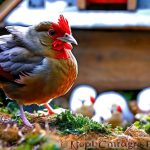Chickens require specific conditions to survive in cold weather, and understanding these requirements is essential for maintaining a healthy flock during winter. Although chickens are generally resilient, they can be vulnerable to low temperatures without proper care and shelter. To stay warm, chickens fluff their feathers, creating an insulating air layer.
They also need access to clean water and nutritious food to maintain energy levels and overall health in colder months. Chickens have developed behavioral adaptations to cope with cold weather. They often huddle together in groups to share body heat, which helps regulate their body temperature.
Additionally, chickens seek out sunny areas in their coop or yard to bask in the warmth. These natural behaviors play a crucial role in their ability to stay comfortable during winter. By comprehending the needs and behaviors of chickens in cold weather, poultry keepers can take appropriate measures to ensure their flock remains healthy and comfortable throughout the winter season.
This knowledge allows for the creation of suitable environments and the implementation of proper care practices to support chickens during colder months.
Table of Contents
- 1 Providing adequate shelter and insulation
- 2 Using heat lamps and heating pads
- 3 Ensuring proper ventilation
- 4 Providing warm bedding and nesting materials
- 5 Offering warm water and nutritious food
- 6 Monitoring and adjusting as needed
- 7 FAQs
- 7.1 What are the best ways to keep chickens warm in freezing temperatures?
- 7.2 How can I insulate my chicken coop to keep it warm in freezing temperatures?
- 7.3 Is it safe to use heat lamps or heated pads to keep chickens warm in freezing temperatures?
- 7.4 What should I consider when using heat lamps or heated pads for my chickens?
- 7.5 How can I ensure proper ventilation in the chicken coop during freezing temperatures?
Key Takeaways
- Chickens need extra care in cold weather due to their susceptibility to frostbite and respiratory issues
- Adequate shelter with insulation such as straw or wood shavings is essential to protect chickens from the cold
- Heat lamps and heating pads can be used to provide additional warmth, but must be used with caution to prevent fires
- Proper ventilation is crucial to prevent moisture buildup and ammonia levels in the coop
- Providing warm bedding such as hay or shredded paper, and nesting materials like straw or shredded leaves, can help chickens stay warm
- Offering warm water and nutritious food, including high-energy treats, can help chickens maintain their body temperature and energy levels
- Regular monitoring of chickens’ behavior and adjusting their environment as needed is important to ensure their well-being in cold weather
Providing adequate shelter and insulation
Insulating the Coop
A well-constructed coop is essential for protecting chickens from the elements and keeping them warm during the winter months. The coop should be insulated to help retain heat and keep out drafts, which can be detrimental to the health of your flock. Insulation can be added to the walls, ceiling, and floor of the coop to help maintain a comfortable temperature inside.
Ventilation and Moisture Control
In addition to insulation, it’s important to ensure that the coop is well-ventilated to prevent moisture buildup, which can lead to respiratory issues in chickens. Proper ventilation will help to remove excess moisture and keep the air fresh and clean.
Designing a Safe and Comfortable Coop
The coop should be designed to provide protection from wind, rain, and snow, and should be large enough to accommodate your entire flock comfortably. It’s also important to provide roosting bars for your chickens to perch on at night, as this helps them stay off the cold ground and retain body heat.
Creating a Comfortable Environment
By providing adequate shelter and insulation, you can create a comfortable and safe environment for your chickens to thrive in during the winter months. With a well-designed and well-insulated coop, your chickens will be protected from the harsh weather conditions and able to stay healthy and happy.
Using heat lamps and heating pads

In some cases, especially in extremely cold climates, additional heat sources may be necessary to keep chickens warm during the winter. Heat lamps and heating pads can be used to provide supplemental warmth in the coop, helping to maintain a comfortable temperature for your flock. Heat lamps can be hung from the ceiling of the coop to provide a source of radiant heat, while heating pads can be placed on the floor to create a warm surface for your chickens to rest on.
It’s important to use these heat sources with caution, as they can pose a fire hazard if not properly installed and monitored. When using heat lamps and heating pads, it’s important to place them in a safe location where they cannot come into contact with flammable materials or be knocked over by your chickens. Additionally, it’s important to monitor the temperature in the coop regularly to ensure that it remains within a safe range for your flock.
While heat lamps and heating pads can be effective tools for keeping chickens warm in cold weather, they should be used as a supplement to proper insulation and shelter, rather than as a primary source of heat.
Ensuring proper ventilation
Proper ventilation is essential for maintaining a healthy environment for your chickens during the winter months. While it may seem counterintuitive, good ventilation is crucial for preventing moisture buildup in the coop, which can lead to respiratory issues in chickens. Ventilation allows fresh air to circulate through the coop, helping to remove excess moisture and prevent the buildup of harmful gases such as ammonia.
Additionally, proper ventilation helps regulate the temperature inside the coop, preventing it from becoming too hot or too cold. To ensure proper ventilation in the coop, it’s important to provide both intake and exhaust vents to allow for air circulation. Intake vents should be located near the bottom of the coop to allow fresh air to enter, while exhaust vents should be located near the top to allow stale air to escape.
It’s also important to ensure that vents are protected from drafts and predators, while still allowing for adequate airflow. By ensuring proper ventilation in the coop, you can create a healthy and comfortable environment for your chickens to thrive in during the winter months.
Providing warm bedding and nesting materials
In addition to providing adequate shelter and insulation, it’s important to provide your chickens with warm bedding and nesting materials to help them stay comfortable during the winter months. Bedding such as straw or wood shavings can be used to create a warm and cozy environment for your flock to rest in. It’s important to regularly clean and replace bedding as needed to prevent moisture buildup and maintain a clean living environment for your chickens.
Nesting materials are also important for keeping your chickens warm during the winter. Nesting boxes should be filled with soft materials such as straw or hay to provide a comfortable and warm place for your hens to lay their eggs. Additionally, providing extra nesting boxes can help prevent overcrowding and allow all of your hens to have access to a warm nesting spot.
By providing warm bedding and nesting materials, you can help your chickens stay comfortable and healthy throughout the winter months.
Offering warm water and nutritious food

Access to Fresh Water
Chickens need access to fresh water at all times, as dehydration can be a serious issue in cold weather. To prevent water from freezing, heated waterers or regular waterers with heated bases can be used to provide a constant supply of unfrozen water for your flock.
Nutritious Diet for Winter Health
In addition to water, it’s crucial to provide your chickens with a nutritious diet to help them stay healthy during the winter months. A diet high in protein and fat can help chickens maintain their energy levels and stay warm in cold weather. Additionally, offering treats such as scratch grains or mealworms can provide extra calories and help keep your flock happy and healthy during the winter months.
Ensuring a Healthy and Comfortable Flock
By offering warm water and nutritious food, you can help ensure that your chickens have everything they need to stay healthy and comfortable throughout the winter.
Monitoring and adjusting as needed
Finally, it’s important to regularly monitor your flock and make adjustments as needed to ensure their health and well-being during the winter months. This includes checking on your chickens regularly to ensure that they are staying warm and healthy, as well as monitoring the temperature and conditions inside the coop. If necessary, adjustments can be made to provide additional warmth or improve ventilation in the coop.
Additionally, it’s important to pay attention to any changes in behavior or appearance in your flock, as these can be signs of health issues or discomfort. By staying vigilant and making adjustments as needed, you can ensure that your chickens stay healthy and comfortable throughout the winter months. Regular monitoring and adjustments are key to providing the best care for your flock during cold weather.
In conclusion, caring for chickens in cold weather requires an understanding of their specific needs and behaviors, as well as providing adequate shelter, insulation, heat sources, ventilation, bedding, water, and food. By taking these factors into consideration and making adjustments as needed, you can ensure that your flock stays healthy and comfortable throughout the winter months. With proper care and attention, your chickens can thrive even in the coldest of temperatures.
If you’re looking for tips on how to keep chickens warm in freezing temperatures, you may also be interested in learning about the importance of a well-insulated coop. Check out this article on creating a garden chicken coop that provides the necessary warmth and protection for your feathered friends during the winter months.
FAQs
What are the best ways to keep chickens warm in freezing temperatures?
Some of the best ways to keep chickens warm in freezing temperatures include providing a well-insulated coop, using heat lamps or heated pads, and ensuring proper ventilation to prevent moisture buildup.
How can I insulate my chicken coop to keep it warm in freezing temperatures?
You can insulate your chicken coop by using materials such as straw, hay, or wood shavings on the floor, adding extra bedding, sealing any drafts, and using insulation panels or foam boards on the walls.
Is it safe to use heat lamps or heated pads to keep chickens warm in freezing temperatures?
Yes, it is safe to use heat lamps or heated pads to keep chickens warm in freezing temperatures, as long as they are installed properly and monitored regularly to prevent any fire hazards.
What should I consider when using heat lamps or heated pads for my chickens?
When using heat lamps or heated pads for your chickens, it is important to consider the placement of the heat source to prevent any potential fire hazards, as well as ensuring that the chickens have enough space to move away from the heat if they become too warm.
How can I ensure proper ventilation in the chicken coop during freezing temperatures?
You can ensure proper ventilation in the chicken coop during freezing temperatures by installing adjustable vents, using a combination of high and low vents to create airflow, and keeping the coop clean to prevent moisture buildup.
Meet Walter, the feathered-friend fanatic of Florida! Nestled in the sunshine state, Walter struts through life with his feathered companions, clucking his way to happiness. With a coop that’s fancier than a five-star hotel, he’s the Don Juan of the chicken world. When he’s not teaching his hens to do the cha-cha, you’ll find him in a heated debate with his prized rooster, Sir Clucks-a-Lot. Walter’s poultry passion is no yolk; he’s the sunny-side-up guy you never knew you needed in your flock of friends!







